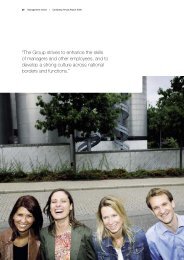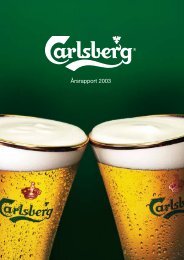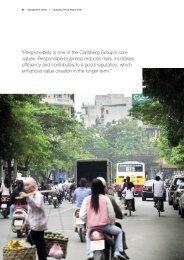Environmental report 2001.pdf - Carlsberg Group
Environmental report 2001.pdf - Carlsberg Group
Environmental report 2001.pdf - Carlsberg Group
- No tags were found...
You also want an ePaper? Increase the reach of your titles
YUMPU automatically turns print PDFs into web optimized ePapers that Google loves.
<strong>Carlsberg</strong> Breweries A/S<strong>Environmental</strong> Report1998 - 2000
<strong>Carlsberg</strong> Breweries A/S<strong>Carlsberg</strong> Breweries <strong>Group</strong><strong>Carlsberg</strong> Breweries is one of the leadingbrewing groups in the world in terms ofsize and geographical reach. It is owned60/40 by <strong>Carlsberg</strong> A/S and Orkla ASA.The two partners, <strong>Carlsberg</strong> and Orkla,have a rich tradition of brewing beer to thehighest standards and a series of strongnational and regional brands that supportprobably one of the world’s largest internationalbrands - <strong>Carlsberg</strong>.<strong>Carlsberg</strong> Breweries has breweries in 43countries and employs more than 29,000people. Its annual production of 60 millionhectolitres beer is equivalent to around 49million 33cl bottles of beer a day. Soft drinkproduction is 12 million hectolitres.The international beer brand <strong>Carlsberg</strong>is available in more than 130 countries.There are also the Tuborg brand anddozens of national brews that represent theEastern, centralEurope, Americasand Africa 38%Asia 17%Total volume by focus areasWestern Europe 45%company in major parts of the world, winninga global reputation in local marketplaces.<strong>Carlsberg</strong> Breweries is guided by thetradition of quality through the applicationof science laid down by the founders of<strong>Carlsberg</strong> and the founders of Orkla’s beveragecompanies Pripps and Ringnes.To this has been added the accumulatedknowledge of all the companies that makeup <strong>Carlsberg</strong> Breweries.<strong>Carlsberg</strong> Breweries has its traditionalbusiness in the beer-drinking nations ofwestern Europe. It also has a strong presencein the growth regions of eastern Europeand Asia, through its joint venture companiesBaltic Beverages Holding AB and<strong>Carlsberg</strong> Asia Ltd.Local production <strong>Carlsberg</strong> BreweriesLicense productionExport markets3<strong>Carlsberg</strong> Breweries not represented 3
ContentVision 6Introduction 7<strong>Environmental</strong> Management 8Local Responsibilities 9Scope of <strong>Environmental</strong> Report 9<strong>Environmental</strong> Prioritisation 10Executive Summary 11Specified <strong>Environmental</strong> PerformancesEnergy Consumption 12Water Consumption 12Waste 13Discharge Waste Water 13CO 2 Emission 14<strong>Environmental</strong> Accidents 14Complaints 14<strong>Environmental</strong> Investments 15Occupational Health and Safety 15Awareness and Training 16<strong>Environmental</strong> Conduct of Suppliers 17Brewing of Beer 18List of Breweries 195
Vision<strong>Carlsberg</strong> Breweries still operates on theheritage of brewer J. C. Jacobsen and hisson Carl Jacobsen - the visionary foundersof <strong>Carlsberg</strong>. Most famous is probably theirformulation of the objectives for theirbreweries known as the "Golden Words"."In working the <strong>Carlsberg</strong> breweries it shouldbe a constant purpose, regardless of immediateprofit, to develop the art of making beer tothe greatest possible degree of perfection inorder that these breweries as well as their productsmay ever stand out as a model and so,through their example, assist in keeping beerbrewing on a high and honourable level".Today this vision still constitutes a significantelement in the development of<strong>Carlsberg</strong> Breweries’ business strategies,including environmental responsibilities.6
Introduction<strong>Environmental</strong> Policy<strong>Carlsberg</strong> Breweriesrecognises its responsibilityfor protectionof the environmentwherever it operates.<strong>Carlsberg</strong> Breweriesseeks to meet theneeds of its consumers,customers, andemployees in an environmentallysoundand sustainable manner,through continuousimprovement inenvironmentalperformance in all<strong>Group</strong> activities.<strong>Carlsberg</strong> Breweriesendeavours systematicallyto minimiseadverse effects on theenvironment andoptimise the use ofnatural resources.Copenhagen, 1 February 2000Flemming LindeløvPresident,Chief Executive Officer<strong>Carlsberg</strong> Breweries A/SAll breweries in which<strong>Carlsberg</strong> Breweriesholds the controllinginterest are bound by the corporateenvironmental policy. On thebasis of the corporate policy, theindividual breweries develop theirown detailed operational environmentalpolicy, implement managementprocedures to make thepolicy work in practice, and documentand <strong>report</strong> on the performance.This environmental <strong>report</strong> isthe first public <strong>report</strong> on ourenvironmental performance atbreweries, which are either whollyownedbreweries or in which<strong>Carlsberg</strong> Breweries is a majorshareholder. In line with ourobjective to increase our shareholdingin breweries that arealready in the <strong>Carlsberg</strong> Breweries<strong>Group</strong>, we are committed to increasingthe number of breweriesthat adopt our corporate environmentalpolicy.Initially we will broaden thescope of the environmental workso that it also comprises productionof other beverages, maltingfacilities and transportation offinished products using own vehicles.Registration of such data willnot be included in next year’s<strong>report</strong> but in the environmental<strong>report</strong> published in 2003.It is also our objective to contributeto sustainable development.Therefore, our <strong>report</strong>ingstructure will gradually evolvetowards an integration of ourfinancial and environmental performances,with <strong>report</strong>ing on ourvalues and responsibilities towardsour other stakeholders and societyat large.Through membership of localand international business organisationssuch as The Brewers ofEurope and the European RoundTable of Industrialists, experiencesare exchanged to the benefitof the environment.Flemming LindeløvPresident, Chief Executive Officer<strong>Carlsberg</strong> Breweries A/S7
<strong>Environmental</strong> Management<strong>Carlsberg</strong> Breweries is committed to operatingall its breweries efficiently and in afinancially and environmentally responsiblemanner, in due time establishing an environmentalmanagement system in everybrewery.The management system will follow therequirements of internationally recognisedstandards, and almost all breweries haveformulated local environmental policiesacknowledging the <strong>Carlsberg</strong> Breweries’corporate environmental policy.Executive Board<strong>Carlsberg</strong> Breweries A/SCorporate environmental policyCorporate Operations ControlCorporate guidelinesMonitoringAnnual environmental conferenceLocal brewery managementLocal environmental policiesProceduresReportingInitial environmental review<strong>Carlsberg</strong> Breweries’<strong>Environmental</strong>Management System.This <strong>report</strong> mirrorsthe first corporateconclusion of the circleAnnual <strong>Environmental</strong>ReportManagement evaluation<strong>Environmental</strong>policyPrioritisation ofenvironmental issuesAnalyses<strong>Environmental</strong> <strong>report</strong>ingquarterly & annuallyTargets & action plansMonitoring quarterly & annually8
KEYFIGURES 1998/1999 200024 breweries 33 breweriesFull time employees, average 12,200 16,100Beer production, hl 24,240,000 29,366,000Other beverages, hl 2,280,000 4,789,000Local Responsibilities●●●●●Local management must formulateown environmental policy whichcomplies with local legislation andthe corporate environmental policyLocal management is fully liable forensuring the proper procedures arein place to manage the day-to-dayenvironmental responsibilitiesFurther improve methods of registrationof environmental data and ensurethey form an integral part of thebreweries' own environmental managementEnsure environmental managementsystems and controls are implementedas required by <strong>Carlsberg</strong>BreweriesContribute towards long-term sustainabilityfor the economy, the environment,and society.Scope of <strong>Environmental</strong> ReportThe environmental <strong>report</strong> includes resultsfrom the traditional brewing <strong>report</strong>ingperiod October 1998 - September 1999,whereas the 2000 figures cover the calendaryear in line with <strong>Carlsberg</strong> Breweries’changing to the calendar year for <strong>report</strong>ingon financial accounts.Total production, hl 26,520,000 34,155,000Employees and total production<strong>Carlsberg</strong> beer is presently available inmore than 130 countries. The beer is brewedat 67 breweries located in 43 differentcountries.The ownership of the different breweriesand thereby the enforcement of theoperational control varies between breweriesin which <strong>Carlsberg</strong> Breweries is a majorshareholder, breweries in which <strong>Carlsberg</strong>Breweries has a minority shareholding, andbreweries producing the products of<strong>Carlsberg</strong> Breweries under license.The most significant differencesbetween the 1998/1999 andthe 2000 <strong>report</strong>ing periods arethat the environmental resultsfrom Pripps Breweries in Sweden,Ringnes Breweries in Norway, andHue Brewery and South East AsiaBrewery in Vietnam have beenincluded whereas the breweryShanghai, China has been excluded.The <strong>report</strong>ed results of the environmentalmanagement include the total brewingprocess including filling of beer in bottles,kegs, cans or lager containers, productionof energy and warehousing. The <strong>report</strong>excludes the environmental impact ofwarehouses outside the sites of the breweriesand distribution to warehouses andcustomers.9
<strong>Environmental</strong> PrioritisationFollowing a careful assessment of the environmentalimpact, it has been decided tocategorise the environmental managementtasks into four areas which all need controland management attention.Category 1 Category 2 Category 3 Category 4Reduction of resources Monitoring Establish contingency plans Monitor consumption● Water ● Solid waste ● Chemicals and oil spills ● Kieselguhr● Electricity ● Health and safety ● Fire ● Filtration aids● Oil and gas ● Noise ● Dust explosions ● Packaging materials● Extract losses ● Odour ● Lubrication oils● Waste water ● Air emission ● NH3(organic material)● Caustic soda● Detergents10
SummaryExecutive Summary●●●●●●●●●●●●The year 2000 <strong>report</strong>ing period includes33 breweries which is an increase of ninecompared to the previous yearTotal production of beverages includedin the <strong>Environmental</strong> Report increasedby approx. 29 per centThe volume of soft drinks increased from8.6 to 14 per cent of the total productionEmission of CO 2 measured in kg/hl oftotal production fell from 12.8 kg/hlto 11.4 kg/hl, partly from a decrease inthe consumption of fossil fuels and partlyfrom an increased use of hydro-electricpowerTotal consumption of energy fellsignificantly from 45.8 kWh/hl to40.7 kWh/hl in year 2000Consumption of water per hectolitre ofbeer produced has fallen as a resultof increased focus on reducingconsumptionNumber of accidents per million workinghours has fallen from 43 to 37 in year2000For year 2000 only one legal case was<strong>report</strong>ed by a brewery which was finedthe equivalent of DKK 5,000 forexceeding effluent permits17 complaints from neighbours,authorities or other stakeholders havebeen <strong>report</strong>edAssessment of the present level ofenvironmental management at33 breweries has identified manymanagement initiatives that can bere-used in more formal managementsystemsAt present, five breweries have achieved acertification of their environmentalmanagement system according to theISO 14001 requirementsA number of training and awarenessactivities have been initiated.Total consumption of energy and waterPARAMETERS UNIT 98/99 200024 breweries33 breweriesCO 2 tons 340,000 388,000CO 2 kg/hl total production 12.8 11.4Waste water hl water/hl total production 3.8 3.7Waste water kg COD/hl total production 1.3 1.3Solid waste kg/hl total production 2.9 2.9By-products kg/hl beer production 14.2 12.5<strong>Group</strong> average emissions, discharge and solid waste and by-products.COD means Chermical Oxygen Demand11
Specified <strong>Environmental</strong>PerformancesThe most important environmental responsibilitiesare the consistent efforts to reduceresource consumption e.g. energy, andwater as well as discharge of waste water.consumption and improved quality of <strong>report</strong>ingthrough the benchmarking system.Natural gas is the resource primarily usedfor heating.Energy ConsumptionPARAMETERS 98/99 200024 breweries 33 breweriesWater ConsumptionPARAMETERS 98/99 200024 breweries 33 breweriesElectricity, MWh 297,024 437,770Oil and gas, MWh 914,940 951,820Water, m 3 13,848,000 16,280,000Water, hl/hl total production 5.2 4.8Total MWh 1,211,964 1,389,590Total energy consumption used for productionWater consumptionIn year 2000, the average consumption ofelectricity increased from 11.2 to 12.8kWh/hl total production, and the averageoil and gas consumption decreased from34.5 to 27.9 kWh/hl total production ofbeer and soft drinks. The increase in consumptionof electricity is mainly due to theNorwegian breweries using hydro-electricpower for heating instead of fossil fuels.In year 2000, the total energy consumptionused in the production of beer andsoft drinks was 40.7kWh/hl which representsa significant decreasefrom 45.8 kWh/hl in1998/1999. The decreasein total energy consumptionis primarily due toan increased focus onThe natural ingredients wholesome barley,hops, pure yeast plus a large amount of softand clean water are the most importantingredients in the production of beer. Totalwater consumption has increased in linewith increased production.The production-weighted average waterconsumption in year 2000 has been calculatedto 4.8 hl/hl total production of beveragesversus the <strong>report</strong>ed consumption of 5.2hl/hl the previous year.12
WasteThe total generation of solid waste was102,590 tons during year 2000.For both <strong>report</strong>ing years the production-weightedaverage solid waste generationis 3 kg/hl total production.Nearly 95 per cent of the total solidwaste including glass and metal is beingrecycled. Of the remaining 5 per cent someof the solid waste incinerated is used by"waste to energy" plants, thus also beingrecycled. Land application covers wastewater sludge and by-products used for sanitarylandfill. Spent grains and yeast areexcellent as animal fodder ingredients.Discharge Waste WaterBefore the waste water is purified it mainlycontains acid from the cleaning of productionplants, alkaline detergents used forcleaning of returnable bottles as well asorganic materials from the fermentationand barley processes.Waste water is either purified in thebreweries’ own plant or sent to the publictreatment plant.COD is a measuring unit for theamount of organic substances in wastewater. The discharge of organic substances(COD per hl) is unchanged during the two<strong>report</strong>ing years. The production-weightedaverage for waste water discharge is 3.8 hlWW/hl total production as <strong>report</strong>ed forboth <strong>report</strong>ing years.PARAMETERS 98/99 200024 breweries33 breweriesWaste water, m 3 /month 835,000 1,065,900Discharge kg COD/hl 1.3 1.3RecyclingIncinerationSanitary landfill Special wasteDisposal of solid waste and by-productsAverage monthly waste water discharge. COD (ChemicalOxygen Demand) is measured before any treatment of wastewaterThe majority of breweries have a fixed procedureeither on a yearly or quarterly basisfor assessment of solid waste.13
CO 2 EmissionCO 2 from breweries partly stems from thefermentation process and partly from burningof fossil fuels. According to the UnitedNations <strong>Environmental</strong> Programme,CO 2 from the fermentation process is consideredenvironmentally neutral becauseemission of such CO 2 is absorbed by germinatingbarley, which will later be used as araw material for beer brewing.CO 2 from burning is calculated accordingto the type of energy being used. Forexample, the calculation of CO 2 emissionsfrom electricity takes into account whetherit is produced using for example oil, coalor hydro power.The total emissions of CO 2 have onlyrisen by around 14 per cent from1998/1999 to year 2000 despite an increasein the number of breweries and a rise intotal production of 29 per cent.Emissions of CO 2 measured in kg/hl oftotal production fell from 12.8 kg/hl to11.4 kg/hl partly from a decrease in theconsumption of fossil fuels and partly anincreased use of hydro-electric power.PARAMETERS 98/99 2000CO 2 tons 340,000 388,000CO 2 kg/hl total production 12.8 11.4Emission of CO 224 breweries33 breweries<strong>Environmental</strong> AccidentsNo environmental accidents have been<strong>report</strong>ed. The breweries have taken a numberof management initiatives, in order toprevent and control potential environmentalaccidents.Air emissionNoiseWaste waterOdourSpread of 17 complaintsComplaintsDuring year 2000, one brewery was finedthe equivalent of DKK 5,000 for violation ofeffluent permits.Six breweries have <strong>report</strong>ed that theyare periodically in breach of their effluentlimits, but that improvement is progressing.Progress is monitored by <strong>Carlsberg</strong>Corporate Operations Control.17 complaints from stakeholders, e. g.neighbours and authorities have been<strong>report</strong>ed. It should be noted that a complaintdoes not indicate the brewery is violatingany emission nor effluent permits.Overall the compliance and handling ofcomplaints are found to be acceptable. It isa target to implement a formal complaintsystem in all breweries.14
<strong>Environmental</strong> InvestmentsCapital investments of DKK 77.2 millionduring the <strong>report</strong>ing periods were partlyearmarked for environmental protectionand partly for improvement of resourceefficiency.The largest single environmental investmentof DKK 9.6 million was an extensionof the waste water treatment plant at<strong>Carlsberg</strong> Malaysia as part of investments ina planned increased production capacity.<strong>Environmental</strong> investmentsPARAMETERS 98/99 2000Number of employees 12,200 16,100Working hours/month 1,267,000 1,497,000Accidents/million working hours 43 37Sick-days related to accidents/million working hours 374 293Average health and safety figures24 breweriesNearly all breweries have established aformal organisation which addresses healthand safety matter, and the majority of breweriesgenerate health and safety statistics.29 breweries have established and maintaina specific registry of chemicals used. Inaddition, 28 breweries have a procedurefor evaluating potential health and safetyproblems of chemicals before they are usedin production.33 breweriesDistribution of investmentsOther investmentsQuarterlyNo informationHealth and Safety<strong>Carlsberg</strong> Breweries works at ensuring ahealthy and safe working environment forall employees and other stakeholders.The definition of a health and safetyaccident is now a uniform definition for all<strong>Group</strong> breweries. The same goes for sickdaysrelated to accidents. The positivedecrease in accidents and sick-days ismainly due to the fact that eight Scandinavianbreweries, which are included in the<strong>report</strong>ing for 2000, all have a long traditionfor high awareness of health, safety andenvironmental matters.MonthlyIntervals of health and safety statisticsYearly15
Awareness and TrainingCommitted employees is a precondition forsuccessful environmental management. Tomotivate employees and increase theirenvironmental knowledge and awareness,<strong>Carlsberg</strong> Corporate Operations Controlhas initiated a number of activities.●●●●The first environmental managementcourse was held in April 2000.The evaluation of the course was verypositiveCourses for brewmasters also includeenvironmental management andmethods to reduce resource consumptionThe staff of <strong>Carlsberg</strong> CorporateOperations Control have been trainedon the job in the form of seminars,detailed individual work sessionsinvolving the analyses of the1998/1999 environmental <strong>report</strong>and results of quarterly benchmarksTo maintain and further developcommitment to environmental matters,an international conference washeld in May 2001.The local breweries have to a large extentbeen active in the awareness and trainingof both decision-makers and the generalworkforce.Approximately 75 per cent of the brewerieshave <strong>report</strong>ed that training and awarenessof management have been initiated or16
%completed. Almost the same statementgoes for the group of selected employeesthat have been identified to play an importantrole.The breweries have <strong>report</strong>ed a significantincrease in environmental training,and they recognise the importance of thehuman influence on achieving improvementof the environment.<strong>Environmental</strong> Conduct ofSuppliersKnowledge about the environmental performanceof suppliers becomes an importantelement in the continued striving forenvironmental excellence of the supplychain.Breweries that already have an accreditedenvironmental management systemhave addressed the subject of suppliers’environmental performance. Furthermore,other breweries have contacted <strong>Carlsberg</strong>Corporate Operations Control in order toobtain inspiration to formulate and introducea procurement policy, which alsoincludes environmental demands on suppliers.ManagersSelectedemployeesAllemployeesStatus of environmental training and awarenessNot plannedPlannedInitiatedCompleted17
Brewing of Beer12The core activities of <strong>Carlsberg</strong> Breweriesare brewing, distribution and marketing ofbeer. The company sets high standards forall of its primary activities - not least thebrewing of beer.Wholesome barley, pure yeast, hops,plus clear and soft water are the mostimportant ingredients in beer.The brewing of beer is a refined processthat first involves malting of the barley.After the barley is dried and screened, it is4683795the brewing cycle is fermentation. It takesaround one week for pure yeast to convertthe sugar to alcohol and carbon dioxide.Once the temperature is regulated from14°C to 7°C, the yeast sediments are cropped.7)The beer matures for several weeks intanks to develop the desired taste andaroma. The matured beer is very thoroughlyfiltered, 8) making it sparkling, clear andready 9) for bottling using state-of-the-artequipment. 10) The beer10bottles are sealed, labelledand controlled againbefore they are ready tostart their journey to theconsumers.The brewing processsteeped in water for around two days 1) andthen transferred to germination boxes, 2)where it stays for six to eight days. Duringgermination, enzymes are formed in themalt that are crucial to the subsequentbrewing process. Once the malt is dried itis crushed 3) and mixed with water to createa so-called mash, which is heated to 76°C 4)allowing the enzymes to convert the starchinto sugar.Clarified mash, 5) called wort, is boiledwith hops, which contribute to the characteristictaste of the beer. 6) The next step in18
Breweries included in the <strong>Environmental</strong> Report1998/1999 2000<strong>Carlsberg</strong> Brewery, Guangdong, China<strong>Carlsberg</strong> Brewery, Shanghai, ChinaPanonska, Croatia<strong>Carlsberg</strong>, Copenhagen, DenmarkTuborg, Fredericia, DenmarkSinebrychoff, Kerava, FinlandSinebrychoff, Pori, FinlandHannen, GermanyNuuk Imeq, Greenland<strong>Carlsberg</strong> Italia, Ceccano, Italy<strong>Carlsberg</strong> Italia, Varese, ItalySvyturys, LithuaniaCMBL, MalawiCBMB, MalaysiaGorkha Brewery, NepalOkocim, Brzesko, PolandOkocim, Krakow, PolandUnicer, Loule, PortugalUnicer, Porto, PortugalUnicer, Santarem, PortugalVena, RussiaFalcon, Sweden<strong>Carlsberg</strong>-Tetley, Leeds, UK<strong>Carlsberg</strong>-Tetley, Northampton, UK<strong>Carlsberg</strong> Brewery, Guangdong, China<strong>Carlsberg</strong> Brewery, Shanghai, ChinaPanonska, Croatia<strong>Carlsberg</strong>, Copenhagen, DenmarkTuborg, Fredericia, DenmarkSinebrychoff, Kerava, FinlandSinebrychoff, Pori, FinlandHannen, GermanyNuuk Imeq, Greenland<strong>Carlsberg</strong> Italia, Ceccano, Italy<strong>Carlsberg</strong> Italia, Varese, ItalySvyturys, LithuaniaCMBL, MalawiCBMB, MalaysiaGorkha Brewery, NepalRingnes, Arendal, NorwayRingnes, Bodø, NorwayRingnes, Oslo, NorwayRingnes, Stavanger, NorwayRingnes, Trondheim, NorwayOkocim, Brzesko, PolandOkocim, Krakow, PolandUnicer, Loule, PortugalUnicer, Porto, PortugalUnicer, Santarem, PortugalVena, RussiaPripps, Gothenburg, SwedenPripps, Stockholm, SwedenFalcon, Sweden<strong>Carlsberg</strong>-Tetley, Leeds, UK<strong>Carlsberg</strong>-Tetley, Northampton, UKHue Brewery, VietnamSEAB, Hanoi, Vietnam19
<strong>Carlsberg</strong> Breweries A/S100, Ny <strong>Carlsberg</strong> VejDK-1760 - Copenhagen VDenmarkTel +45 33 27 33 00Internet:E-mail:www.carlsberg.comcarlsberg@carlsberg.comJune 2001Lay-out, production:Eneqvist Kommunikation/Kailow Print



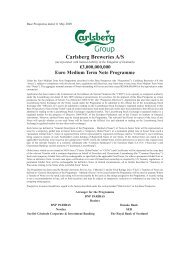
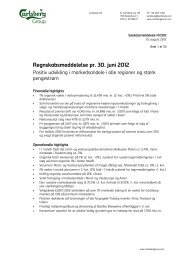

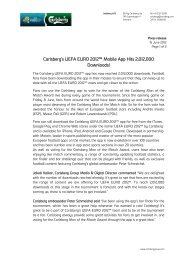
![[Name and Address] - Carlsberg Group](https://img.yumpu.com/49766377/1/184x260/name-and-address-carlsberg-group.jpg?quality=85)

![[Name and Address] - Carlsberg Group](https://img.yumpu.com/49015962/1/184x260/name-and-address-carlsberg-group.jpg?quality=85)
